An Analysis of the Life and Works of Ding Yanyong: Chinese Art
VerifiedAdded on 2023/03/20
|7
|1547
|84
Essay
AI Summary
This essay delves into the life and artistic contributions of Ding Yanyong, a renowned Chinese painter of the last century, exploring his unique blend of Western and Eastern aesthetics. It examines his early life, education in Japan, and his integration of various art forms. The essay analyzes the relationship between Yanyong's art and the Four Perfections of Chinese literati art: painting, calligraphy, seal carving, and poetry. It discusses his use of bright colors, vivid lines, and flat surfaces in his earlier works, and his later evolution into diverse forms, including oil and ink paintings. The essay also provides examples of his calligraphy, seal carvings, and poetry, demonstrating his mastery of these art forms. Ultimately, the essay concludes that Ding Yanyong stands as a significant figure in Chinese art history due to his ability to combine Western and Eastern art styles, making him a prominent artist of his time. The essay is supported by references to scholarly articles and visual examples of his work, including "Crane (1976)", "My Concubine (1975)", and "Bamboo, Rock and Bird (1975)", and concludes that Ding Yanyong's expert use of diverse art forms made him a key figure in Chinese art.
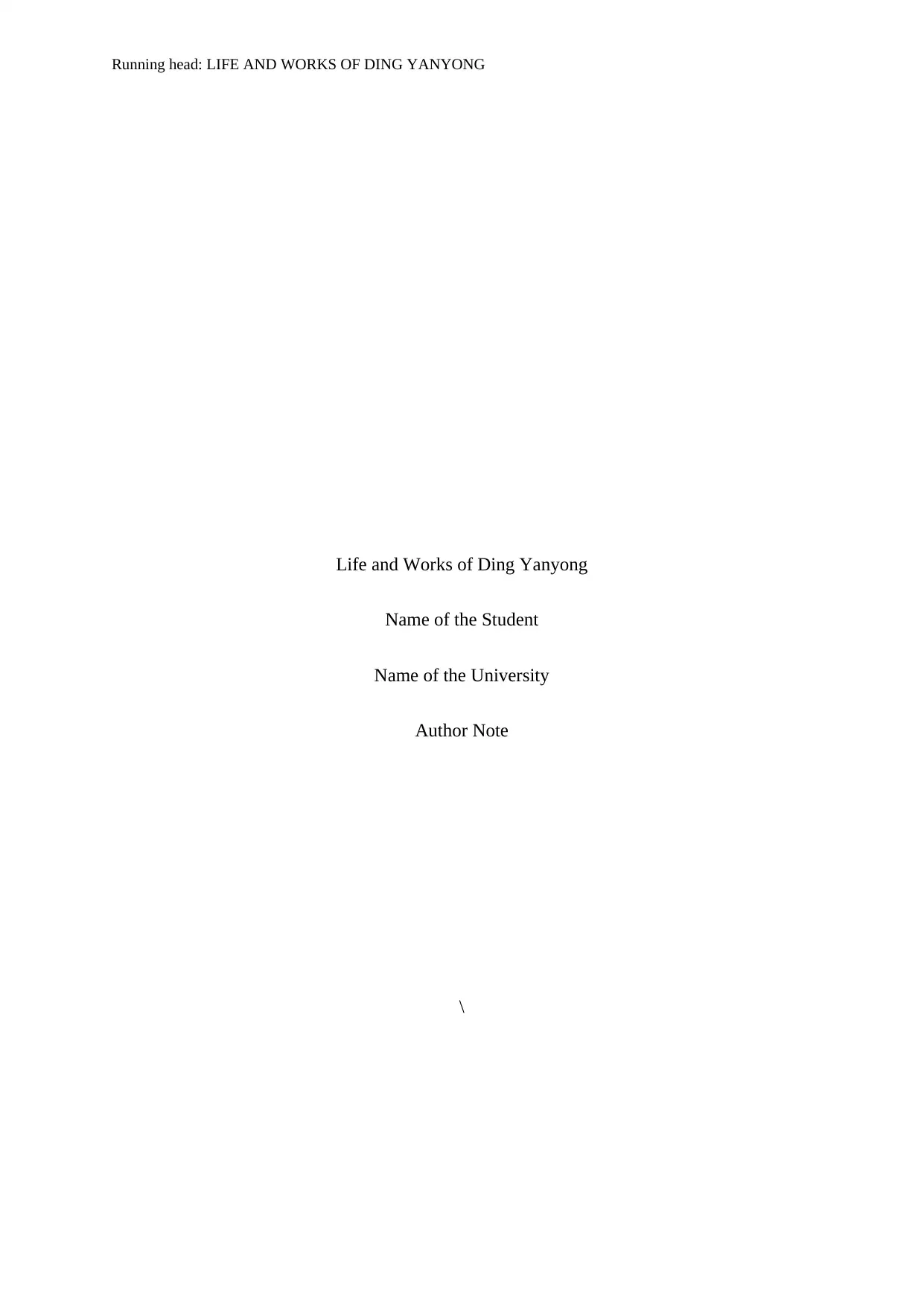
Running head: LIFE AND WORKS OF DING YANYONG
Life and Works of Ding Yanyong
Name of the Student
Name of the University
Author Note
\
Life and Works of Ding Yanyong
Name of the Student
Name of the University
Author Note
\
Paraphrase This Document
Need a fresh take? Get an instant paraphrase of this document with our AI Paraphraser
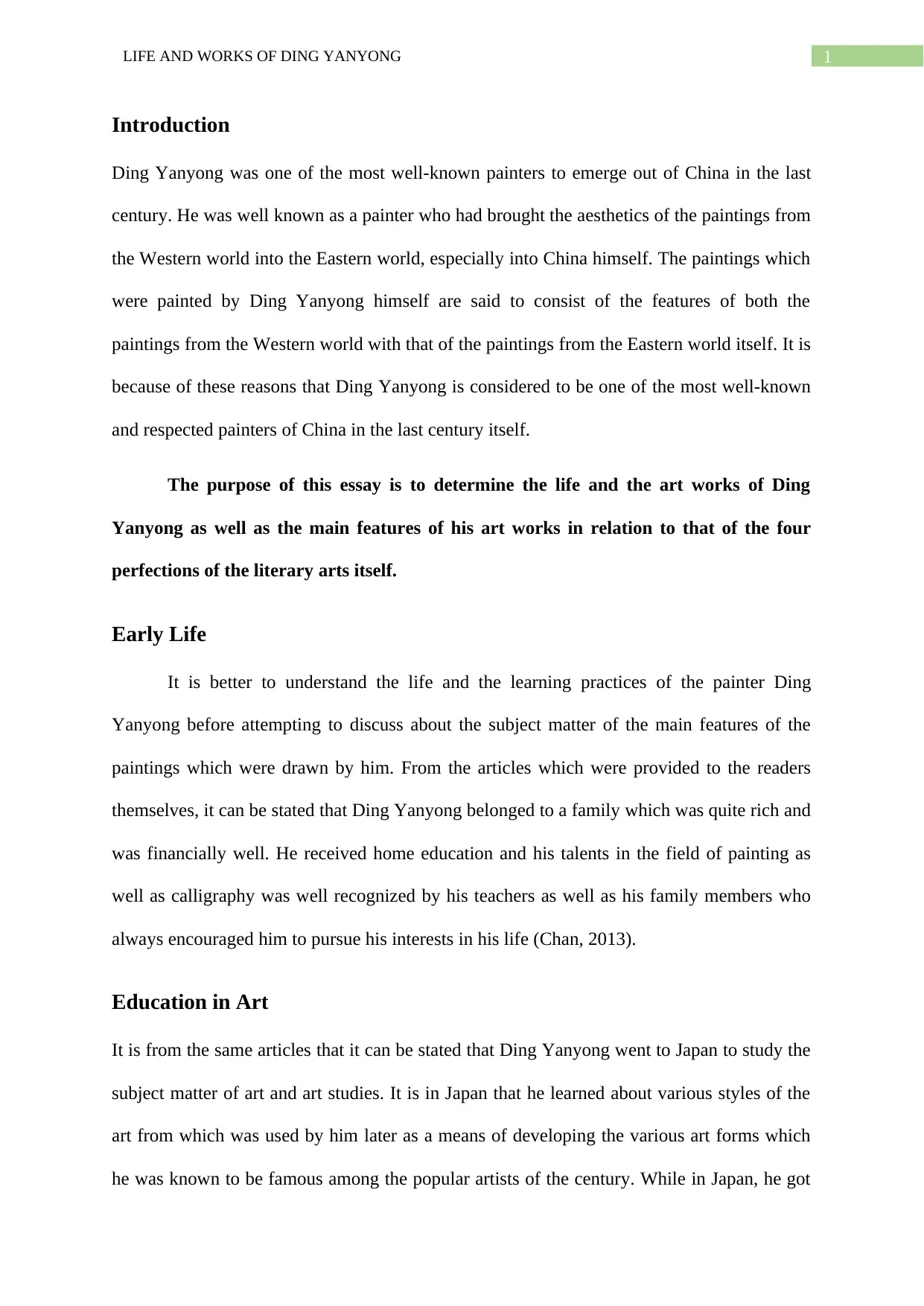
1LIFE AND WORKS OF DING YANYONG
Introduction
Ding Yanyong was one of the most well-known painters to emerge out of China in the last
century. He was well known as a painter who had brought the aesthetics of the paintings from
the Western world into the Eastern world, especially into China himself. The paintings which
were painted by Ding Yanyong himself are said to consist of the features of both the
paintings from the Western world with that of the paintings from the Eastern world itself. It is
because of these reasons that Ding Yanyong is considered to be one of the most well-known
and respected painters of China in the last century itself.
The purpose of this essay is to determine the life and the art works of Ding
Yanyong as well as the main features of his art works in relation to that of the four
perfections of the literary arts itself.
Early Life
It is better to understand the life and the learning practices of the painter Ding
Yanyong before attempting to discuss about the subject matter of the main features of the
paintings which were drawn by him. From the articles which were provided to the readers
themselves, it can be stated that Ding Yanyong belonged to a family which was quite rich and
was financially well. He received home education and his talents in the field of painting as
well as calligraphy was well recognized by his teachers as well as his family members who
always encouraged him to pursue his interests in his life (Chan, 2013).
Education in Art
It is from the same articles that it can be stated that Ding Yanyong went to Japan to study the
subject matter of art and art studies. It is in Japan that he learned about various styles of the
art from which was used by him later as a means of developing the various art forms which
he was known to be famous among the popular artists of the century. While in Japan, he got
Introduction
Ding Yanyong was one of the most well-known painters to emerge out of China in the last
century. He was well known as a painter who had brought the aesthetics of the paintings from
the Western world into the Eastern world, especially into China himself. The paintings which
were painted by Ding Yanyong himself are said to consist of the features of both the
paintings from the Western world with that of the paintings from the Eastern world itself. It is
because of these reasons that Ding Yanyong is considered to be one of the most well-known
and respected painters of China in the last century itself.
The purpose of this essay is to determine the life and the art works of Ding
Yanyong as well as the main features of his art works in relation to that of the four
perfections of the literary arts itself.
Early Life
It is better to understand the life and the learning practices of the painter Ding
Yanyong before attempting to discuss about the subject matter of the main features of the
paintings which were drawn by him. From the articles which were provided to the readers
themselves, it can be stated that Ding Yanyong belonged to a family which was quite rich and
was financially well. He received home education and his talents in the field of painting as
well as calligraphy was well recognized by his teachers as well as his family members who
always encouraged him to pursue his interests in his life (Chan, 2013).
Education in Art
It is from the same articles that it can be stated that Ding Yanyong went to Japan to study the
subject matter of art and art studies. It is in Japan that he learned about various styles of the
art from which was used by him later as a means of developing the various art forms which
he was known to be famous among the popular artists of the century. While in Japan, he got
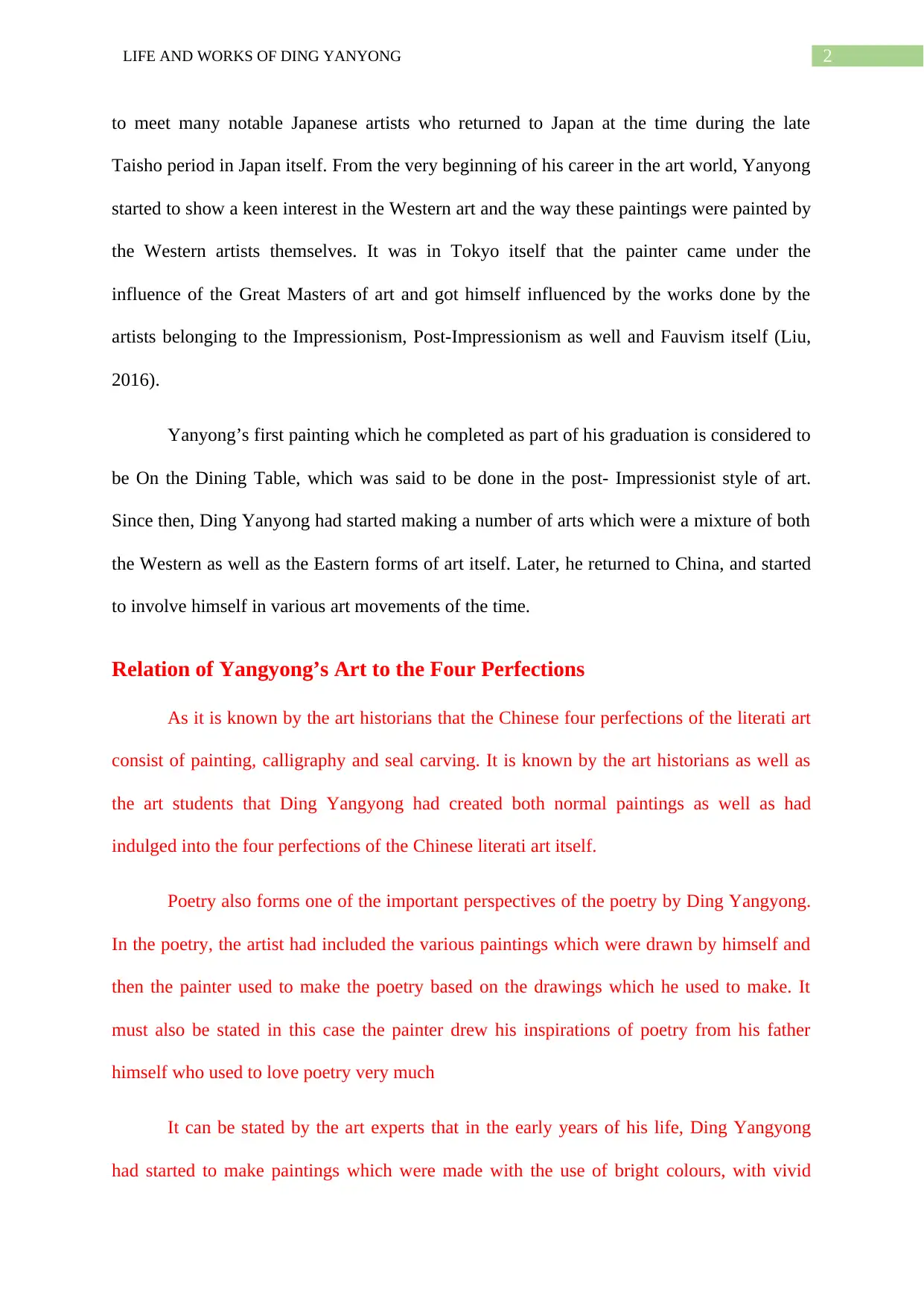
2LIFE AND WORKS OF DING YANYONG
to meet many notable Japanese artists who returned to Japan at the time during the late
Taisho period in Japan itself. From the very beginning of his career in the art world, Yanyong
started to show a keen interest in the Western art and the way these paintings were painted by
the Western artists themselves. It was in Tokyo itself that the painter came under the
influence of the Great Masters of art and got himself influenced by the works done by the
artists belonging to the Impressionism, Post-Impressionism as well and Fauvism itself (Liu,
2016).
Yanyong’s first painting which he completed as part of his graduation is considered to
be On the Dining Table, which was said to be done in the post- Impressionist style of art.
Since then, Ding Yanyong had started making a number of arts which were a mixture of both
the Western as well as the Eastern forms of art itself. Later, he returned to China, and started
to involve himself in various art movements of the time.
Relation of Yangyong’s Art to the Four Perfections
As it is known by the art historians that the Chinese four perfections of the literati art
consist of painting, calligraphy and seal carving. It is known by the art historians as well as
the art students that Ding Yangyong had created both normal paintings as well as had
indulged into the four perfections of the Chinese literati art itself.
Poetry also forms one of the important perspectives of the poetry by Ding Yangyong.
In the poetry, the artist had included the various paintings which were drawn by himself and
then the painter used to make the poetry based on the drawings which he used to make. It
must also be stated in this case the painter drew his inspirations of poetry from his father
himself who used to love poetry very much
It can be stated by the art experts that in the early years of his life, Ding Yangyong
had started to make paintings which were made with the use of bright colours, with vivid
to meet many notable Japanese artists who returned to Japan at the time during the late
Taisho period in Japan itself. From the very beginning of his career in the art world, Yanyong
started to show a keen interest in the Western art and the way these paintings were painted by
the Western artists themselves. It was in Tokyo itself that the painter came under the
influence of the Great Masters of art and got himself influenced by the works done by the
artists belonging to the Impressionism, Post-Impressionism as well and Fauvism itself (Liu,
2016).
Yanyong’s first painting which he completed as part of his graduation is considered to
be On the Dining Table, which was said to be done in the post- Impressionist style of art.
Since then, Ding Yanyong had started making a number of arts which were a mixture of both
the Western as well as the Eastern forms of art itself. Later, he returned to China, and started
to involve himself in various art movements of the time.
Relation of Yangyong’s Art to the Four Perfections
As it is known by the art historians that the Chinese four perfections of the literati art
consist of painting, calligraphy and seal carving. It is known by the art historians as well as
the art students that Ding Yangyong had created both normal paintings as well as had
indulged into the four perfections of the Chinese literati art itself.
Poetry also forms one of the important perspectives of the poetry by Ding Yangyong.
In the poetry, the artist had included the various paintings which were drawn by himself and
then the painter used to make the poetry based on the drawings which he used to make. It
must also be stated in this case the painter drew his inspirations of poetry from his father
himself who used to love poetry very much
It can be stated by the art experts that in the early years of his life, Ding Yangyong
had started to make paintings which were made with the use of bright colours, with vivid
⊘ This is a preview!⊘
Do you want full access?
Subscribe today to unlock all pages.

Trusted by 1+ million students worldwide
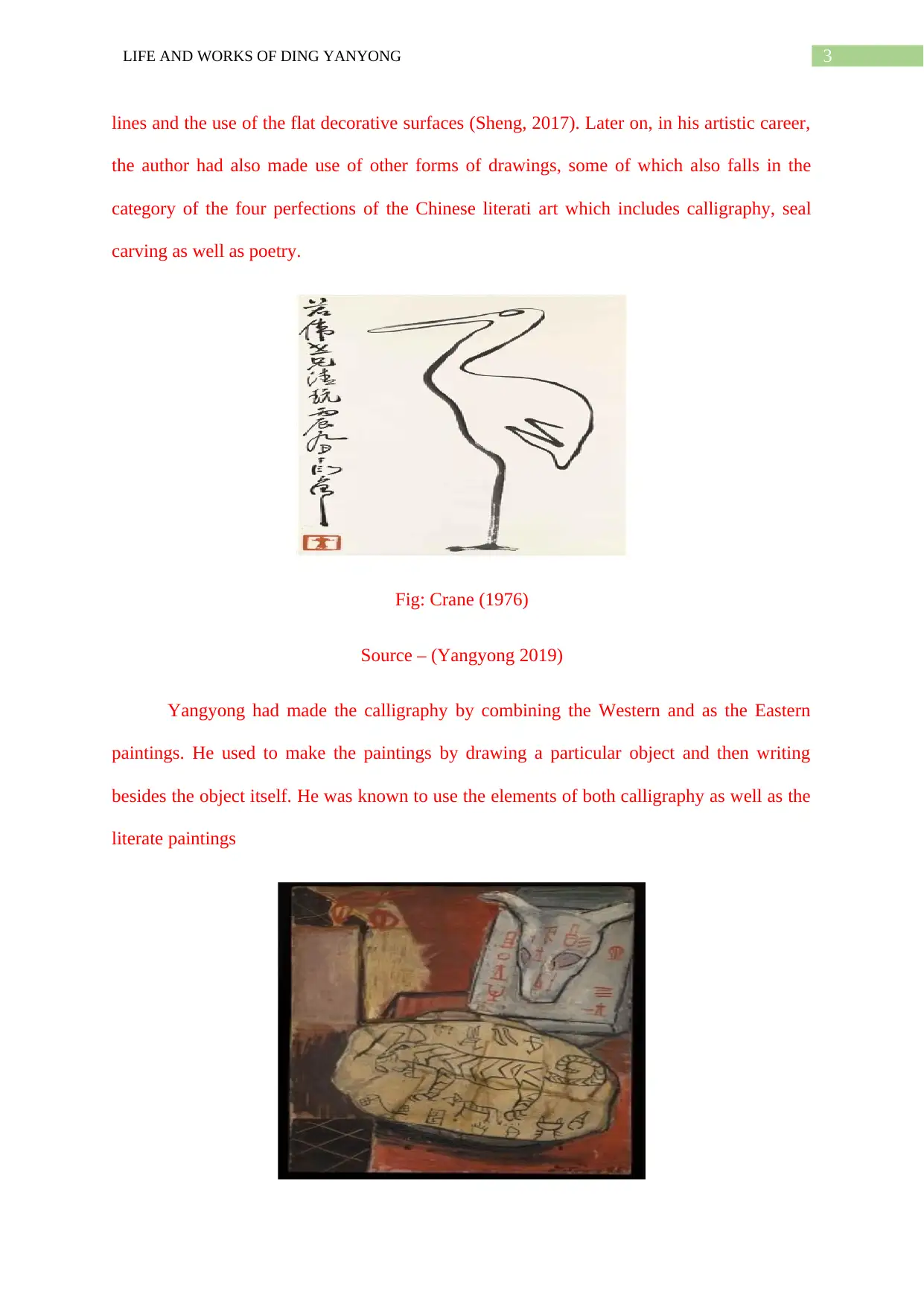
3LIFE AND WORKS OF DING YANYONG
lines and the use of the flat decorative surfaces (Sheng, 2017). Later on, in his artistic career,
the author had also made use of other forms of drawings, some of which also falls in the
category of the four perfections of the Chinese literati art which includes calligraphy, seal
carving as well as poetry.
Fig: Crane (1976)
Source – (Yangyong 2019)
Yangyong had made the calligraphy by combining the Western and as the Eastern
paintings. He used to make the paintings by drawing a particular object and then writing
besides the object itself. He was known to use the elements of both calligraphy as well as the
literate paintings
lines and the use of the flat decorative surfaces (Sheng, 2017). Later on, in his artistic career,
the author had also made use of other forms of drawings, some of which also falls in the
category of the four perfections of the Chinese literati art which includes calligraphy, seal
carving as well as poetry.
Fig: Crane (1976)
Source – (Yangyong 2019)
Yangyong had made the calligraphy by combining the Western and as the Eastern
paintings. He used to make the paintings by drawing a particular object and then writing
besides the object itself. He was known to use the elements of both calligraphy as well as the
literate paintings
Paraphrase This Document
Need a fresh take? Get an instant paraphrase of this document with our AI Paraphraser
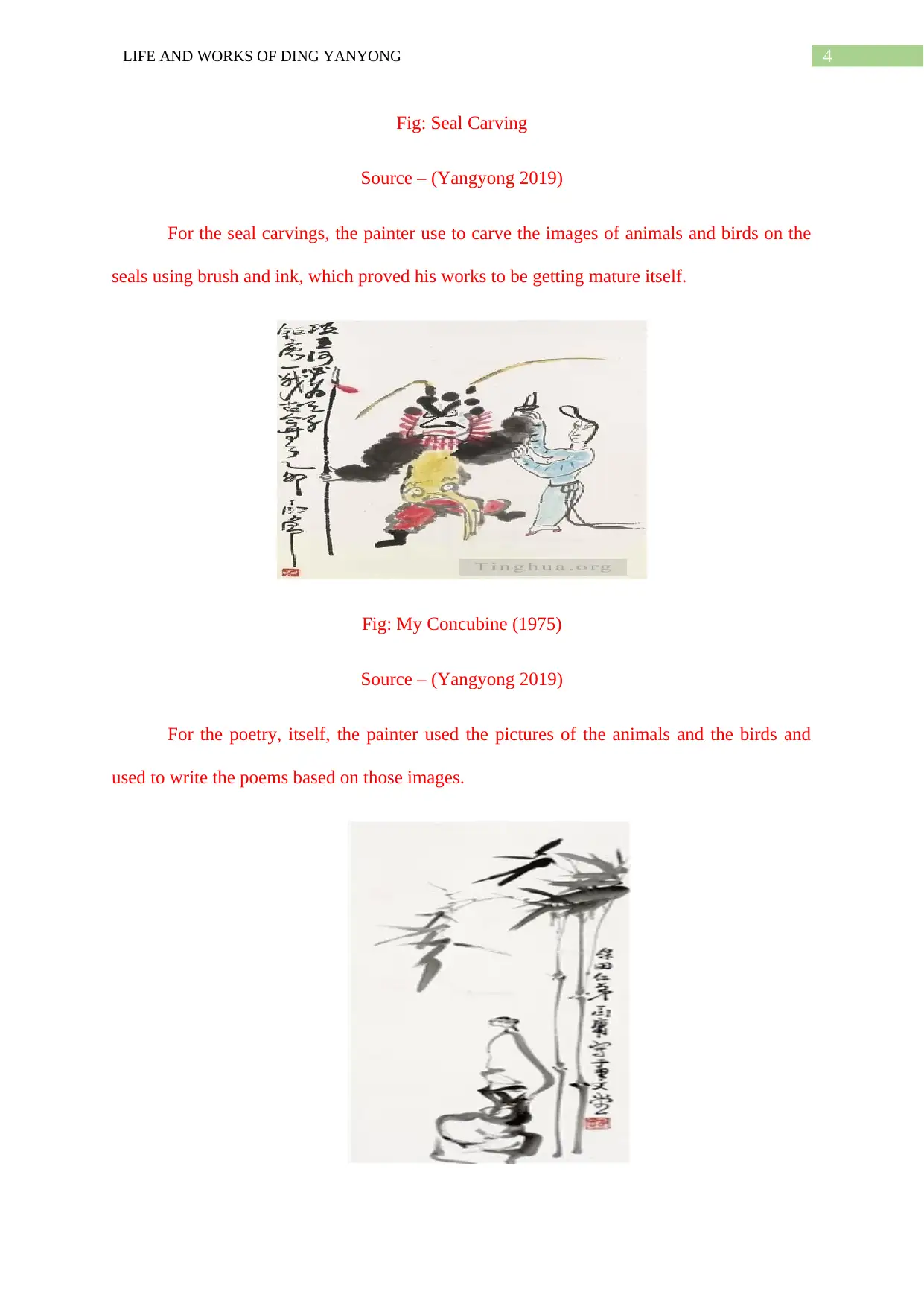
4LIFE AND WORKS OF DING YANYONG
Fig: Seal Carving
Source – (Yangyong 2019)
For the seal carvings, the painter use to carve the images of animals and birds on the
seals using brush and ink, which proved his works to be getting mature itself.
Fig: My Concubine (1975)
Source – (Yangyong 2019)
For the poetry, itself, the painter used the pictures of the animals and the birds and
used to write the poems based on those images.
Fig: Seal Carving
Source – (Yangyong 2019)
For the seal carvings, the painter use to carve the images of animals and birds on the
seals using brush and ink, which proved his works to be getting mature itself.
Fig: My Concubine (1975)
Source – (Yangyong 2019)
For the poetry, itself, the painter used the pictures of the animals and the birds and
used to write the poems based on those images.
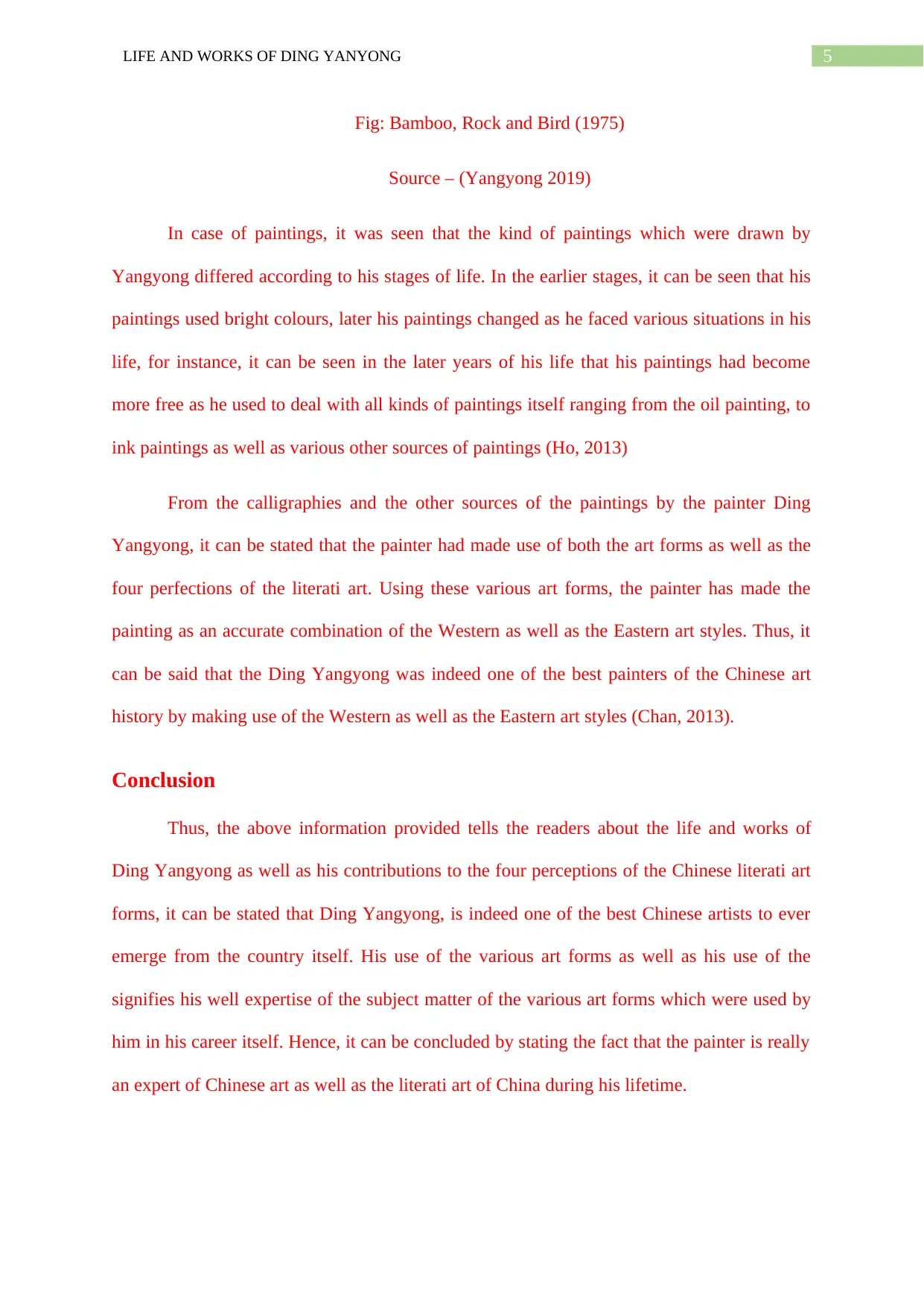
5LIFE AND WORKS OF DING YANYONG
Fig: Bamboo, Rock and Bird (1975)
Source – (Yangyong 2019)
In case of paintings, it was seen that the kind of paintings which were drawn by
Yangyong differed according to his stages of life. In the earlier stages, it can be seen that his
paintings used bright colours, later his paintings changed as he faced various situations in his
life, for instance, it can be seen in the later years of his life that his paintings had become
more free as he used to deal with all kinds of paintings itself ranging from the oil painting, to
ink paintings as well as various other sources of paintings (Ho, 2013)
From the calligraphies and the other sources of the paintings by the painter Ding
Yangyong, it can be stated that the painter had made use of both the art forms as well as the
four perfections of the literati art. Using these various art forms, the painter has made the
painting as an accurate combination of the Western as well as the Eastern art styles. Thus, it
can be said that the Ding Yangyong was indeed one of the best painters of the Chinese art
history by making use of the Western as well as the Eastern art styles (Chan, 2013).
Conclusion
Thus, the above information provided tells the readers about the life and works of
Ding Yangyong as well as his contributions to the four perceptions of the Chinese literati art
forms, it can be stated that Ding Yangyong, is indeed one of the best Chinese artists to ever
emerge from the country itself. His use of the various art forms as well as his use of the
signifies his well expertise of the subject matter of the various art forms which were used by
him in his career itself. Hence, it can be concluded by stating the fact that the painter is really
an expert of Chinese art as well as the literati art of China during his lifetime.
Fig: Bamboo, Rock and Bird (1975)
Source – (Yangyong 2019)
In case of paintings, it was seen that the kind of paintings which were drawn by
Yangyong differed according to his stages of life. In the earlier stages, it can be seen that his
paintings used bright colours, later his paintings changed as he faced various situations in his
life, for instance, it can be seen in the later years of his life that his paintings had become
more free as he used to deal with all kinds of paintings itself ranging from the oil painting, to
ink paintings as well as various other sources of paintings (Ho, 2013)
From the calligraphies and the other sources of the paintings by the painter Ding
Yangyong, it can be stated that the painter had made use of both the art forms as well as the
four perfections of the literati art. Using these various art forms, the painter has made the
painting as an accurate combination of the Western as well as the Eastern art styles. Thus, it
can be said that the Ding Yangyong was indeed one of the best painters of the Chinese art
history by making use of the Western as well as the Eastern art styles (Chan, 2013).
Conclusion
Thus, the above information provided tells the readers about the life and works of
Ding Yangyong as well as his contributions to the four perceptions of the Chinese literati art
forms, it can be stated that Ding Yangyong, is indeed one of the best Chinese artists to ever
emerge from the country itself. His use of the various art forms as well as his use of the
signifies his well expertise of the subject matter of the various art forms which were used by
him in his career itself. Hence, it can be concluded by stating the fact that the painter is really
an expert of Chinese art as well as the literati art of China during his lifetime.
⊘ This is a preview!⊘
Do you want full access?
Subscribe today to unlock all pages.

Trusted by 1+ million students worldwide
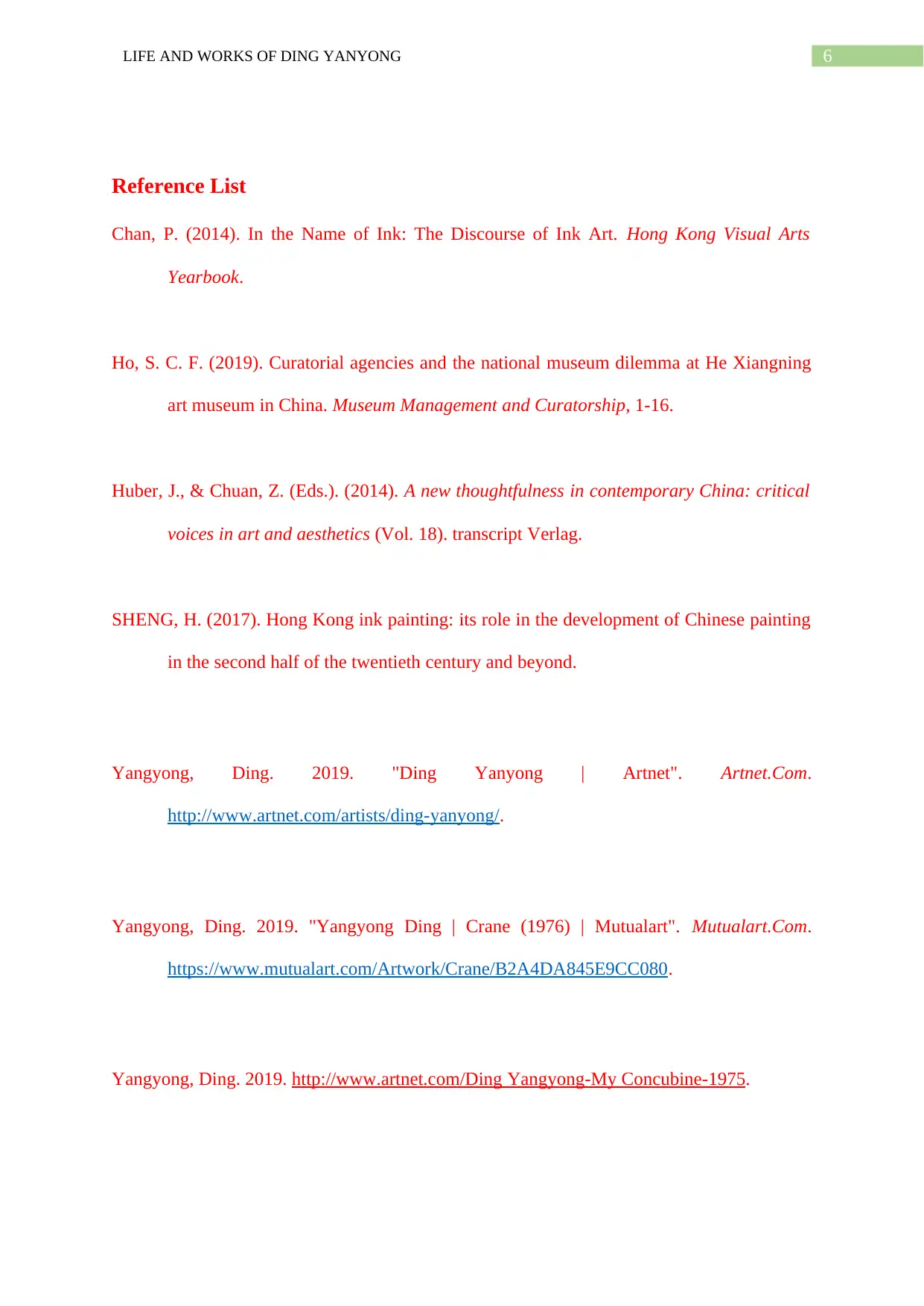
6LIFE AND WORKS OF DING YANYONG
Reference List
Chan, P. (2014). In the Name of Ink: The Discourse of Ink Art. Hong Kong Visual Arts
Yearbook.
Ho, S. C. F. (2019). Curatorial agencies and the national museum dilemma at He Xiangning
art museum in China. Museum Management and Curatorship, 1-16.
Huber, J., & Chuan, Z. (Eds.). (2014). A new thoughtfulness in contemporary China: critical
voices in art and aesthetics (Vol. 18). transcript Verlag.
SHENG, H. (2017). Hong Kong ink painting: its role in the development of Chinese painting
in the second half of the twentieth century and beyond.
Yangyong, Ding. 2019. "Ding Yanyong | Artnet". Artnet.Com.
http://www.artnet.com/artists/ding-yanyong/.
Yangyong, Ding. 2019. "Yangyong Ding | Crane (1976) | Mutualart". Mutualart.Com.
https://www.mutualart.com/Artwork/Crane/B2A4DA845E9CC080.
Yangyong, Ding. 2019. http://www.artnet.com/Ding Yangyong-My Concubine-1975.
Reference List
Chan, P. (2014). In the Name of Ink: The Discourse of Ink Art. Hong Kong Visual Arts
Yearbook.
Ho, S. C. F. (2019). Curatorial agencies and the national museum dilemma at He Xiangning
art museum in China. Museum Management and Curatorship, 1-16.
Huber, J., & Chuan, Z. (Eds.). (2014). A new thoughtfulness in contemporary China: critical
voices in art and aesthetics (Vol. 18). transcript Verlag.
SHENG, H. (2017). Hong Kong ink painting: its role in the development of Chinese painting
in the second half of the twentieth century and beyond.
Yangyong, Ding. 2019. "Ding Yanyong | Artnet". Artnet.Com.
http://www.artnet.com/artists/ding-yanyong/.
Yangyong, Ding. 2019. "Yangyong Ding | Crane (1976) | Mutualart". Mutualart.Com.
https://www.mutualart.com/Artwork/Crane/B2A4DA845E9CC080.
Yangyong, Ding. 2019. http://www.artnet.com/Ding Yangyong-My Concubine-1975.
1 out of 7
Related Documents
Your All-in-One AI-Powered Toolkit for Academic Success.
+13062052269
info@desklib.com
Available 24*7 on WhatsApp / Email
![[object Object]](/_next/static/media/star-bottom.7253800d.svg)
Unlock your academic potential
Copyright © 2020–2025 A2Z Services. All Rights Reserved. Developed and managed by ZUCOL.





